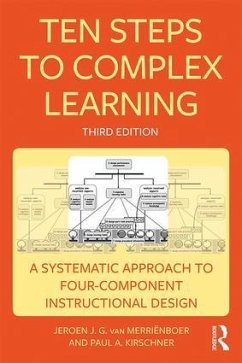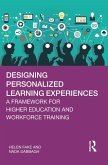Jeroen J. G. van Merrienboer (The Netherland Maastricht University, Paul A. Kirschner (Open Univeristy of the Netherlands)
Ten Steps to Complex Learning
A Systematic Approach to Four-Component Instructional Design
Jeroen J. G. van Merrienboer (The Netherland Maastricht University, Paul A. Kirschner (Open Univeristy of the Netherlands)
Ten Steps to Complex Learning
A Systematic Approach to Four-Component Instructional Design
- Broschiertes Buch
- Merkliste
- Auf die Merkliste
- Bewerten Bewerten
- Teilen
- Produkt teilen
- Produkterinnerung
- Produkterinnerung
Ten Steps to Complex Learning presents a path from a training problem to a training solution in a way that students, practitioners (both instructional designers and teachers), and researchers can understand and easily implement.
Andere Kunden interessierten sich auch für
![Ten Steps to Complex Learning Ten Steps to Complex Learning]() Jeroen J. G. van Merrienboer (The Netherland Maastricht UniversityTen Steps to Complex Learning55,99 €
Jeroen J. G. van Merrienboer (The Netherland Maastricht UniversityTen Steps to Complex Learning55,99 €![The Mobile Course Design Journey The Mobile Course Design Journey]() Alex RockeyThe Mobile Course Design Journey46,99 €
Alex RockeyThe Mobile Course Design Journey46,99 €![Constructing Online Work-Based Learning Placements Constructing Online Work-Based Learning Placements]() Lisa TaylorConstructing Online Work-Based Learning Placements43,99 €
Lisa TaylorConstructing Online Work-Based Learning Placements43,99 €![Designing Personalized Learning Experiences Designing Personalized Learning Experiences]() Helen FakeDesigning Personalized Learning Experiences64,99 €
Helen FakeDesigning Personalized Learning Experiences64,99 €![Co-Creating Digital Curricula in Higher Education Co-Creating Digital Curricula in Higher Education]() Alain A. NoghiuCo-Creating Digital Curricula in Higher Education46,99 €
Alain A. NoghiuCo-Creating Digital Curricula in Higher Education46,99 €![The Encyclopedia of Female Pioneers in Online Learning The Encyclopedia of Female Pioneers in Online Learning]() Susan BainbridgeThe Encyclopedia of Female Pioneers in Online Learning51,99 €
Susan BainbridgeThe Encyclopedia of Female Pioneers in Online Learning51,99 €![Artificial Intelligence Applications in Higher Education Artificial Intelligence Applications in Higher Education]() Artificial Intelligence Applications in Higher Education41,99 €
Artificial Intelligence Applications in Higher Education41,99 €-
-
-
Ten Steps to Complex Learning presents a path from a training problem to a training solution in a way that students, practitioners (both instructional designers and teachers), and researchers can understand and easily implement.
Hinweis: Dieser Artikel kann nur an eine deutsche Lieferadresse ausgeliefert werden.
Hinweis: Dieser Artikel kann nur an eine deutsche Lieferadresse ausgeliefert werden.
Produktdetails
- Produktdetails
- Verlag: Taylor & Francis Ltd
- 3 ed
- Seitenzahl: 400
- Erscheinungstermin: 24. Oktober 2017
- Englisch
- Abmessung: 229mm x 152mm x 22mm
- Gewicht: 610g
- ISBN-13: 9781138080805
- ISBN-10: 1138080802
- Artikelnr.: 48900092
- Herstellerkennzeichnung
- Libri GmbH
- Europaallee 1
- 36244 Bad Hersfeld
- gpsr@libri.de
- Verlag: Taylor & Francis Ltd
- 3 ed
- Seitenzahl: 400
- Erscheinungstermin: 24. Oktober 2017
- Englisch
- Abmessung: 229mm x 152mm x 22mm
- Gewicht: 610g
- ISBN-13: 9781138080805
- ISBN-10: 1138080802
- Artikelnr.: 48900092
- Herstellerkennzeichnung
- Libri GmbH
- Europaallee 1
- 36244 Bad Hersfeld
- gpsr@libri.de
Jeroen J. G. van Merriënboer is Professor of Learning and Instruction at Maastricht University, the Netherlands, where he is Research Director of the Graduate School of Health Professions Education (SHE). He also holds honorary positions at the University of Bergen in Norway and the Open University of the Netherlands. He has published over 300 journal articles and book chapters in the areas of learning and instruction and medical education. Paul A. Kirschner is Distinguished University Professor and Professor of Educational Psychology at the Open University of the Netherlands, as well as Visiting Professor of Education with a special emphasis on Learning and Interaction in Teacher Education at the University of Oulu, Finland. He has published more than 300 journal articles, books, and book chapters in the areas of learning, instruction, and collaborative learning.
CONTENTS
About the Authors
Preface
Acknowledgements
1 A NEW APPROACH TO INSTRUCTION
1.1 Complex Learning
1.2 A Holistic Design Approach
1.3 Four Components and Ten Steps
2 FOUR BLUEPRINT COMPONENTS
2.1 Training Blueprints
2.2 Preventing Compartmentalization
2.3 Avoiding Fragmentation
2.4 Dealing with the Transfer Paradox
2.5 Individualized Instruction
2.6 Media for the Four Components
2.7 Summary
3 TEN STEPS
3.1 Ten Design Activities
3.2 System Dynamics
3.3 The Pebble-in-the-Pond: From Activities to Steps
3.4 Ten Steps within an ISD Context
3.5 Summary
4 STEP 1: DESIGN LEARNING TASKS
4.1 Real-Life Tasks
4.2 Real and Simulated Task Environments
4.3 Variability of Practice
4.4 Learner Support and Guidance
4.5 Built-in Task Support
4.6 Problem-Solving Guidance
4.7 Scaffolding Support and Guidance
4.8 Summary of Guidelines
5 STEP 2: DESIGN PERFORMANCE ASSESSMENTS
5.1 Skill Decomposition
5.2 Formulating Performance Objectives
5.3 Classifying Performance Objectives
5.4 Performance Assessments
5.5 Summary of Guidelines
6 STEP 3: SEQUENCE LEARNING TASKS
6.1 Whole-Task Sequencing of Learning Tasks
6.2 Task Classes and Learner Support
6.3 Part-Task Sequencing of Learning Tasks
6.4 Individualized Learning Trajectories
6.5 Summary of Guidelines
7 STEP 4: DESIGN SUPPORTIVE INFORMATION
7.1 Providing SAPs and Domain Models
7.2 Illustrating SAPs and Domain Models
7.3 Strategies for Presenting Supportive Information
7.4 Cognitive Feedback
7.5 Media for Supportive Information
7.6 Supportive Information in the Training Blueprint
7.7 Summary of Guidelines
8 STEP 5: ANALYZE COGNITIVE STRATEGIES
8.1 Specify SAPs
8.2 Analyzing Intuitive Cognitive Strategies
8.3 Using SAPs to Make Design Decisions
8.4 Summary of Guidelines
9 STEP 6: ANALYZE MENTAL MODELS
9.1 Specify Domain Models
9.2 Analyzing Intuitive Mental Models
9.3 Using Domain Models to Make Design Decisions
9.4 Summary of Guidelines
10 STEP 7: DESIGN PROCEDURAL INFORMATION
10.1 Providing Just-In-Time Information Displays
10.2 Exemplifying Just-In-Time Information
10.3 Strategies for Presenting Procedural Information
10.4 Corrective Feedback
10.5 Media for Procedural Information
10.6 Procedural Information in the Training Blueprint
10.7 Summary of Guidelines
11 STEP 8: ANALYZE COGNITIVE RULES
11.1 Specify IF-THEN Rules and Procedures
11.2 Analyzing Typical Errors and Malrules
11.3 Using Cognitive Rules to Make Design Decisions
11.4 Summary of Guidelines
12 STEP 9: ANALYZE PREREQUISITE KNOWLEDGE
12.1 Specify Concepts, Facts, and Physical Models
12.2 Analyzing Misconceptions
12.3 Using Prerequisite Knowledge to Make Design Decisions
12.4 Summary of Guidelines
13 STEP 10: DESIGN PART-TASK PRACTICE
13.1 Practice Items
13.2 Part-Task Sequencing for Part-Task Practice
13.3 Procedural Information for Part-Task Practice
13.4 Overlearning
13.5 Independent Part-Task Practice
13.6 Media for Part-Task Practice
13.7 Part-Task Practice in the Training Blueprint
13.8 Summary of Guidelines
14 DOMAIN-GENERAL SKILLS
14.1 Self-Regulated and Self-Directed Learning
14.2 Training Information Literacy Skills
14.3 Deliberate Practice for Building Routines
14.4 21st Century Skills
14.5 Summary
15 PROGRAMS OF ASSESSMENT
15.1 Miller's Pyramid and the Four Components
15.2 Summative Assessment of Learning Tasks
15.3 Summative Assessment of Supportive Information
15.4 Summative Assessment of Part-Tasks and Procedural Information
15.5 Summative Assessment of Domain-General Skills
15.6 Summary
16 CLOSING REMARKS
16.1 Positioning the Ten Steps
16.2 Future Directions
16.3 A Final Word
About the Authors
Preface
Acknowledgements
1 A NEW APPROACH TO INSTRUCTION
1.1 Complex Learning
1.2 A Holistic Design Approach
1.3 Four Components and Ten Steps
2 FOUR BLUEPRINT COMPONENTS
2.1 Training Blueprints
2.2 Preventing Compartmentalization
2.3 Avoiding Fragmentation
2.4 Dealing with the Transfer Paradox
2.5 Individualized Instruction
2.6 Media for the Four Components
2.7 Summary
3 TEN STEPS
3.1 Ten Design Activities
3.2 System Dynamics
3.3 The Pebble-in-the-Pond: From Activities to Steps
3.4 Ten Steps within an ISD Context
3.5 Summary
4 STEP 1: DESIGN LEARNING TASKS
4.1 Real-Life Tasks
4.2 Real and Simulated Task Environments
4.3 Variability of Practice
4.4 Learner Support and Guidance
4.5 Built-in Task Support
4.6 Problem-Solving Guidance
4.7 Scaffolding Support and Guidance
4.8 Summary of Guidelines
5 STEP 2: DESIGN PERFORMANCE ASSESSMENTS
5.1 Skill Decomposition
5.2 Formulating Performance Objectives
5.3 Classifying Performance Objectives
5.4 Performance Assessments
5.5 Summary of Guidelines
6 STEP 3: SEQUENCE LEARNING TASKS
6.1 Whole-Task Sequencing of Learning Tasks
6.2 Task Classes and Learner Support
6.3 Part-Task Sequencing of Learning Tasks
6.4 Individualized Learning Trajectories
6.5 Summary of Guidelines
7 STEP 4: DESIGN SUPPORTIVE INFORMATION
7.1 Providing SAPs and Domain Models
7.2 Illustrating SAPs and Domain Models
7.3 Strategies for Presenting Supportive Information
7.4 Cognitive Feedback
7.5 Media for Supportive Information
7.6 Supportive Information in the Training Blueprint
7.7 Summary of Guidelines
8 STEP 5: ANALYZE COGNITIVE STRATEGIES
8.1 Specify SAPs
8.2 Analyzing Intuitive Cognitive Strategies
8.3 Using SAPs to Make Design Decisions
8.4 Summary of Guidelines
9 STEP 6: ANALYZE MENTAL MODELS
9.1 Specify Domain Models
9.2 Analyzing Intuitive Mental Models
9.3 Using Domain Models to Make Design Decisions
9.4 Summary of Guidelines
10 STEP 7: DESIGN PROCEDURAL INFORMATION
10.1 Providing Just-In-Time Information Displays
10.2 Exemplifying Just-In-Time Information
10.3 Strategies for Presenting Procedural Information
10.4 Corrective Feedback
10.5 Media for Procedural Information
10.6 Procedural Information in the Training Blueprint
10.7 Summary of Guidelines
11 STEP 8: ANALYZE COGNITIVE RULES
11.1 Specify IF-THEN Rules and Procedures
11.2 Analyzing Typical Errors and Malrules
11.3 Using Cognitive Rules to Make Design Decisions
11.4 Summary of Guidelines
12 STEP 9: ANALYZE PREREQUISITE KNOWLEDGE
12.1 Specify Concepts, Facts, and Physical Models
12.2 Analyzing Misconceptions
12.3 Using Prerequisite Knowledge to Make Design Decisions
12.4 Summary of Guidelines
13 STEP 10: DESIGN PART-TASK PRACTICE
13.1 Practice Items
13.2 Part-Task Sequencing for Part-Task Practice
13.3 Procedural Information for Part-Task Practice
13.4 Overlearning
13.5 Independent Part-Task Practice
13.6 Media for Part-Task Practice
13.7 Part-Task Practice in the Training Blueprint
13.8 Summary of Guidelines
14 DOMAIN-GENERAL SKILLS
14.1 Self-Regulated and Self-Directed Learning
14.2 Training Information Literacy Skills
14.3 Deliberate Practice for Building Routines
14.4 21st Century Skills
14.5 Summary
15 PROGRAMS OF ASSESSMENT
15.1 Miller's Pyramid and the Four Components
15.2 Summative Assessment of Learning Tasks
15.3 Summative Assessment of Supportive Information
15.4 Summative Assessment of Part-Tasks and Procedural Information
15.5 Summative Assessment of Domain-General Skills
15.6 Summary
16 CLOSING REMARKS
16.1 Positioning the Ten Steps
16.2 Future Directions
16.3 A Final Word
CONTENTS
About the Authors
Preface
Acknowledgements
1 A NEW APPROACH TO INSTRUCTION
1.1 Complex Learning
1.2 A Holistic Design Approach
1.3 Four Components and Ten Steps
2 FOUR BLUEPRINT COMPONENTS
2.1 Training Blueprints
2.2 Preventing Compartmentalization
2.3 Avoiding Fragmentation
2.4 Dealing with the Transfer Paradox
2.5 Individualized Instruction
2.6 Media for the Four Components
2.7 Summary
3 TEN STEPS
3.1 Ten Design Activities
3.2 System Dynamics
3.3 The Pebble-in-the-Pond: From Activities to Steps
3.4 Ten Steps within an ISD Context
3.5 Summary
4 STEP 1: DESIGN LEARNING TASKS
4.1 Real-Life Tasks
4.2 Real and Simulated Task Environments
4.3 Variability of Practice
4.4 Learner Support and Guidance
4.5 Built-in Task Support
4.6 Problem-Solving Guidance
4.7 Scaffolding Support and Guidance
4.8 Summary of Guidelines
5 STEP 2: DESIGN PERFORMANCE ASSESSMENTS
5.1 Skill Decomposition
5.2 Formulating Performance Objectives
5.3 Classifying Performance Objectives
5.4 Performance Assessments
5.5 Summary of Guidelines
6 STEP 3: SEQUENCE LEARNING TASKS
6.1 Whole-Task Sequencing of Learning Tasks
6.2 Task Classes and Learner Support
6.3 Part-Task Sequencing of Learning Tasks
6.4 Individualized Learning Trajectories
6.5 Summary of Guidelines
7 STEP 4: DESIGN SUPPORTIVE INFORMATION
7.1 Providing SAPs and Domain Models
7.2 Illustrating SAPs and Domain Models
7.3 Strategies for Presenting Supportive Information
7.4 Cognitive Feedback
7.5 Media for Supportive Information
7.6 Supportive Information in the Training Blueprint
7.7 Summary of Guidelines
8 STEP 5: ANALYZE COGNITIVE STRATEGIES
8.1 Specify SAPs
8.2 Analyzing Intuitive Cognitive Strategies
8.3 Using SAPs to Make Design Decisions
8.4 Summary of Guidelines
9 STEP 6: ANALYZE MENTAL MODELS
9.1 Specify Domain Models
9.2 Analyzing Intuitive Mental Models
9.3 Using Domain Models to Make Design Decisions
9.4 Summary of Guidelines
10 STEP 7: DESIGN PROCEDURAL INFORMATION
10.1 Providing Just-In-Time Information Displays
10.2 Exemplifying Just-In-Time Information
10.3 Strategies for Presenting Procedural Information
10.4 Corrective Feedback
10.5 Media for Procedural Information
10.6 Procedural Information in the Training Blueprint
10.7 Summary of Guidelines
11 STEP 8: ANALYZE COGNITIVE RULES
11.1 Specify IF-THEN Rules and Procedures
11.2 Analyzing Typical Errors and Malrules
11.3 Using Cognitive Rules to Make Design Decisions
11.4 Summary of Guidelines
12 STEP 9: ANALYZE PREREQUISITE KNOWLEDGE
12.1 Specify Concepts, Facts, and Physical Models
12.2 Analyzing Misconceptions
12.3 Using Prerequisite Knowledge to Make Design Decisions
12.4 Summary of Guidelines
13 STEP 10: DESIGN PART-TASK PRACTICE
13.1 Practice Items
13.2 Part-Task Sequencing for Part-Task Practice
13.3 Procedural Information for Part-Task Practice
13.4 Overlearning
13.5 Independent Part-Task Practice
13.6 Media for Part-Task Practice
13.7 Part-Task Practice in the Training Blueprint
13.8 Summary of Guidelines
14 DOMAIN-GENERAL SKILLS
14.1 Self-Regulated and Self-Directed Learning
14.2 Training Information Literacy Skills
14.3 Deliberate Practice for Building Routines
14.4 21st Century Skills
14.5 Summary
15 PROGRAMS OF ASSESSMENT
15.1 Miller's Pyramid and the Four Components
15.2 Summative Assessment of Learning Tasks
15.3 Summative Assessment of Supportive Information
15.4 Summative Assessment of Part-Tasks and Procedural Information
15.5 Summative Assessment of Domain-General Skills
15.6 Summary
16 CLOSING REMARKS
16.1 Positioning the Ten Steps
16.2 Future Directions
16.3 A Final Word
About the Authors
Preface
Acknowledgements
1 A NEW APPROACH TO INSTRUCTION
1.1 Complex Learning
1.2 A Holistic Design Approach
1.3 Four Components and Ten Steps
2 FOUR BLUEPRINT COMPONENTS
2.1 Training Blueprints
2.2 Preventing Compartmentalization
2.3 Avoiding Fragmentation
2.4 Dealing with the Transfer Paradox
2.5 Individualized Instruction
2.6 Media for the Four Components
2.7 Summary
3 TEN STEPS
3.1 Ten Design Activities
3.2 System Dynamics
3.3 The Pebble-in-the-Pond: From Activities to Steps
3.4 Ten Steps within an ISD Context
3.5 Summary
4 STEP 1: DESIGN LEARNING TASKS
4.1 Real-Life Tasks
4.2 Real and Simulated Task Environments
4.3 Variability of Practice
4.4 Learner Support and Guidance
4.5 Built-in Task Support
4.6 Problem-Solving Guidance
4.7 Scaffolding Support and Guidance
4.8 Summary of Guidelines
5 STEP 2: DESIGN PERFORMANCE ASSESSMENTS
5.1 Skill Decomposition
5.2 Formulating Performance Objectives
5.3 Classifying Performance Objectives
5.4 Performance Assessments
5.5 Summary of Guidelines
6 STEP 3: SEQUENCE LEARNING TASKS
6.1 Whole-Task Sequencing of Learning Tasks
6.2 Task Classes and Learner Support
6.3 Part-Task Sequencing of Learning Tasks
6.4 Individualized Learning Trajectories
6.5 Summary of Guidelines
7 STEP 4: DESIGN SUPPORTIVE INFORMATION
7.1 Providing SAPs and Domain Models
7.2 Illustrating SAPs and Domain Models
7.3 Strategies for Presenting Supportive Information
7.4 Cognitive Feedback
7.5 Media for Supportive Information
7.6 Supportive Information in the Training Blueprint
7.7 Summary of Guidelines
8 STEP 5: ANALYZE COGNITIVE STRATEGIES
8.1 Specify SAPs
8.2 Analyzing Intuitive Cognitive Strategies
8.3 Using SAPs to Make Design Decisions
8.4 Summary of Guidelines
9 STEP 6: ANALYZE MENTAL MODELS
9.1 Specify Domain Models
9.2 Analyzing Intuitive Mental Models
9.3 Using Domain Models to Make Design Decisions
9.4 Summary of Guidelines
10 STEP 7: DESIGN PROCEDURAL INFORMATION
10.1 Providing Just-In-Time Information Displays
10.2 Exemplifying Just-In-Time Information
10.3 Strategies for Presenting Procedural Information
10.4 Corrective Feedback
10.5 Media for Procedural Information
10.6 Procedural Information in the Training Blueprint
10.7 Summary of Guidelines
11 STEP 8: ANALYZE COGNITIVE RULES
11.1 Specify IF-THEN Rules and Procedures
11.2 Analyzing Typical Errors and Malrules
11.3 Using Cognitive Rules to Make Design Decisions
11.4 Summary of Guidelines
12 STEP 9: ANALYZE PREREQUISITE KNOWLEDGE
12.1 Specify Concepts, Facts, and Physical Models
12.2 Analyzing Misconceptions
12.3 Using Prerequisite Knowledge to Make Design Decisions
12.4 Summary of Guidelines
13 STEP 10: DESIGN PART-TASK PRACTICE
13.1 Practice Items
13.2 Part-Task Sequencing for Part-Task Practice
13.3 Procedural Information for Part-Task Practice
13.4 Overlearning
13.5 Independent Part-Task Practice
13.6 Media for Part-Task Practice
13.7 Part-Task Practice in the Training Blueprint
13.8 Summary of Guidelines
14 DOMAIN-GENERAL SKILLS
14.1 Self-Regulated and Self-Directed Learning
14.2 Training Information Literacy Skills
14.3 Deliberate Practice for Building Routines
14.4 21st Century Skills
14.5 Summary
15 PROGRAMS OF ASSESSMENT
15.1 Miller's Pyramid and the Four Components
15.2 Summative Assessment of Learning Tasks
15.3 Summative Assessment of Supportive Information
15.4 Summative Assessment of Part-Tasks and Procedural Information
15.5 Summative Assessment of Domain-General Skills
15.6 Summary
16 CLOSING REMARKS
16.1 Positioning the Ten Steps
16.2 Future Directions
16.3 A Final Word








